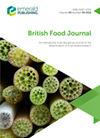功能性食品质量预期识别:女性消费者视角
IF 3.4
3区 经济学
Q1 AGRICULTURAL ECONOMICS & POLICY
引用次数: 0
摘要
目的本研究旨在确定消费者对功能性食品的期望质量。本研究调查了女性消费者对功能性食品的期望质量维度和指标。设计/方法论/方法本研究采用了定量方法。数据是通过使用自填问卷对大雅加达地区149名17岁及以上女性进行的调查收集的。数据分析包括三个阶段:探索性因素分析(EFA)、验证性因素分析结构方程建模(CFA-SEM)和消费者期望值分析。社会科学统计软件包(SPSS)和Lisrel软件用于辅助分析。结果分析结果表明,女性期望功能性食品在产品展示、产品保证、方便性、健康益处以及安全性和感官特征等方面得到满足。这五个方面被称为预期质量维度。21项指标可用于衡量妇女期望的功能性食品的质量。研究局限性/含义其他研究人员可以利用这项研究来了解功能性食品女性消费者的行为。此外,功能性食品公司可以利用它来衡量消费者对其产品质量和性能的期望。独创性/价值这项研究被认为是第一项确定女性消费者期望的功能性食品质量维度的研究。大多数现有的关于功能性食品感知质量的研究都是根据表现来衡量功能性食品的质量,而忽略了男性和女性之间的期望差异。本文章由计算机程序翻译,如有差异,请以英文原文为准。
The identification of expected functional food quality: female consumers' perspective
PurposeThis study aimed to identify the quality consumers expect from functional food. This study investigated the quality dimensions and indicators female consumers expect in functional food.Design/methodology/approachThis study used a quantitative approach. Data were collected through a survey using a self-administered questionnaire from 149 women aged 17 years and over in the Greater Jakarta area. Data analysis consists of three stages: exploratory factor analysis (EFA), confirmatory factor analysis-structural equation modeling (CFA-SEM) and consumer expectation value analysis. Statistical Package for the Social Sciences (SPSS) and Lisrel software were used to assist the analysis.FindingsThe analysis results showed that women expect functional food products to fulfill the aspects of product presentation, product assurance, convenience, health benefits and safety and sensory characteristics. These five aspects are referred to as the expected quality dimensions. Twenty-one indicators can be used to measure the quality of functional food expected by women.Research limitations/implicationsOther researchers can use this study to understand functional food female consumers' behavior. Furthermore, functional food companies can utilize it to measure consumers' expectations of their products' quality and performance.Originality/valueThis research is believed to be the first study to identify the dimensions of functional food quality expected by female consumers. Most existing research on the perceived quality of functional food measures functional food quality based on performance and ignored the differences in expectations between men and women.
求助全文
通过发布文献求助,成功后即可免费获取论文全文。
去求助
来源期刊

British Food Journal
工程技术-食品科技
CiteScore
6.90
自引率
15.20%
发文量
219
审稿时长
18-36 weeks
期刊介绍:
After 115 years, the British Food Journal (BFJ) continues to be highly respected worldwide for its broad and unique interdisciplinary coverage of the latest food-related double blind peer-reviewed research. It links all sectors of this dynamic industry, keeping abreast of emerging trends, topical and controversial issues and informing and stimulating debate. - See more at: http://emeraldgrouppublishing.com/products/journals/journals.htm?id=bfj#sthash.O3wH4pEh.dpuf
 求助内容:
求助内容: 应助结果提醒方式:
应助结果提醒方式:


